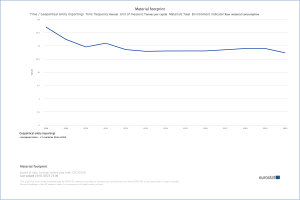INSIGHT by Julia Vol, Sustainability and public affairs consultant
 Recently, Eurostat, the EU’s statistics office, released an interesting document – the revised EU circular economy monitoring framework. This update not only sheds light on the progress (or lack thereof) in the transition to a low-carbon and circular economy but also offers insight into how the EU perceives the concept of circularity. While there are some positive developments, the data proves that we are moving too slow and diving into might help to understand why.
Recently, Eurostat, the EU’s statistics office, released an interesting document – the revised EU circular economy monitoring framework. This update not only sheds light on the progress (or lack thereof) in the transition to a low-carbon and circular economy but also offers insight into how the EU perceives the concept of circularity. While there are some positive developments, the data proves that we are moving too slow and diving into might help to understand why.
Let’s begin with the good news:
〉The number of EU-registered patents related to recycling and the use of secondary raw materials increased by 14% between 2000 and 2019.
〉In 2021, the economic sectors relevant to the circular economy provided 4.3 million jobs, marking an 11% increase compared to 2015.
〉EU greenhouse gas emissions from production activities have decreased by approximately 25% between 2008 and 2021.
However, a closer examination of the data reveals some concerning trends. Over the past decade, the material footprint per capita across the EU has remained stagnant at around 14 tons of material per capita annually. This figure represents the amount of material required to sustain our current consumption patterns. Consequently, it is unsurprising that the rate of waste generation per capita has remained unchanged for the past 20 years. These findings raise some serious doubts about our progress towards a circular economy. Despite intentions and discussions, we still deeply trapped in a linear system.
This linear bias becomes more apparent when we consider the narrow perspective on circularity and circular material use. Even in the revised monitoring framework, waste generation and recycling dominate the discussion, with little mention of waste avoidance, product life extension, design for durability and repairability, the transition to renewable resources, or the shift from products to services. Even the “innovation” indicator itself focuses primarily on new recycling patents.
Undoubtedly, it is more challenging to define and quantify these broader activities compared to measuring the tons of recycled material. However, the transition to a circular economy was never meant to be easy. Shouldn’t we be explicit about what this transition entails and how we can effectively measure it?
The transition to a circular economy was never meant to be easy. Shouldn’t we be explicit about what this transition entails and how we can effectively measure it?
Another critical oversight in the monitoring framework is the absence of social value creation. The document seems to prioritize the circular economy for the sake of the economy and materials, while neglecting the human aspect. Who benefits from this economy, and how do we account for social implications? Shouldn’t we include indicators that measure increased access to goods and services through new business models, improved household incomes resulting from a shift from ownership to access, and reduced toxicity in our environment due to better material choices?
The only indicator that mildly addresses this concern is employment, measuring the rates of employment in the recycling, repair and reuse, and rental and leasing sectors. However, given the disproportionate focus on recycling, it is not surprising that circular jobs remain scarce and far between.
Measuring circularity solely through waste management and recycling is fundamentally flawed. If we do not set higher ambitions for businesses and policymakers to strive toward, circularity will forever remain on the periphery of the economy.
Measuring circularity solely through waste management and recycling is fundamentally flawed. If we do not set higher ambitions for businesses and policymakers to strive toward, circularity will forever remain on the periphery of the economy. In such a scenario, we will continue with business as usual, merely attempting to recycle a little more.
This approach is neither sustainable nor effective. We must acknowledge that incrementalism is dead, and maintaining the status quo is no longer an option. Yes, defining parameters and establishing baselines will be challenging, but without them, how can we expect to succeed?
It is time to redefine the circular economy. We need a holistic approach that encompasses waste avoidance, product life extension, design for durability and repairability, renewable resources, and the transition from ownership to access.
It is time to redefine the circular economy. We need a holistic approach that encompasses waste avoidance, product life extension, design for durability and repairability, renewable resources, and the transition from ownership to access. Moreover, we must incorporate social indicators that measure the positive impacts on people’s lives and well-being.
The revised monitoring framework should reflect this broader vision of circularity, fostering innovation and incentivizing businesses and policymakers to embrace a more ambitious agenda. Only by doing so, we can shift our economy toward a sustainable and regenerative model that benefits both the environment and society.
| about
Julia Vol is a sustainability and public affairs consultant with over 10 years of experience working with leading NGOs developing thought leadership and supporting businesses in their transition to a circular economy.
| All opinions expressed are those of the author and/or quoted sources. investESG.eu is an independent and neutral platform dedicated to generating debate around ESG investing topics.



 >>click to zoom in
>>click to zoom in





